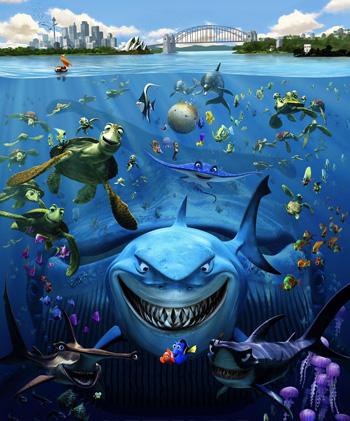This index is for tropes related to animals that live the water or spend most of their time in the water. Aquatic animals also include seabirds and swimming birds. See The Other Wiki for more information.
See Underwater Index for tropes concerning their environment.
Tropes
Categories:
- Aquatic Hadrosaurs: The outdated portrayal of hadrosaur (duck-billed) dinosaurs as water-dwelling animals.
- Aquatic Sauropods: The outdated portrayal of sauropod (long-necked) dinosaurs as water-dwelling animals.
- Artistic License – Marine Biology: Factual inaccuracies about marine life in a work of fiction that make the story work better.
- The Catfish: An individual of a game animal species, usually a large fish, that is a legendarily difficult catch.
- Clamshell Currency: Shelling out in seashells.
- Clamshells as Mouths: Clams and other bivalves being depicted with the shells as jaws for speaking and eating.
- Clam Trap: Giant clams that snap closed on people who approach them, like living beartraps.
- Clingy Aquatic Life: When a character comes out of a body of water with an aquatic animal or plant stuck to them.
- Electric Jellyfish: Jellyfish that shock people with electricity instead of being venomous.
- Fiendish Fish: Dangerous, sometimes outright evil, fish.
- Fish People: Fish-like humanoids.
- Foul Waterfowl: Aquatic birds, especially geese, depicted as aggressive and/or dickish.
- Flying Seafood Special: Flying sea creatures.
- Frog Men: Frog-like humanoids.
- Funnel-Mouthed Cephalopod: An octopus or squid portrayed with a nozzle-like mouth, generally based on the real creatures' syphon.
- Funny Octopus: Octopi as comic and funny creatures.
- Giant Enemy Crab: Outsized, dangerous crabs.
- Giant Squid: Gigantic squid as sea monsters.
- Instant Leech: Just Fall in Water!: Whenever a character accidentally falls into a body of water, especially a stagnant one such as a swamp or pond, and comes to discover a leech — or more — attached to them somewhere.
- Jumping Fish: The presence of fish indicated by having one or more fish literally "jumping" out of a source of water (lake, river, etc.), especially when the characters suggest looking for food.
- Kraken and Leviathan: Gigantic deep sea monsters that are known for attacking ships.
- Legendary Carp: Carps in media, especially ones that pay homage to Japanese history, having mystical properties.
- Makara: A sea monster from Hindu Mythology.
- Mellow Mantas: Manta rays are portrayed as gentle and graceful.
- Mobile Fishbowl: When an aquatic character brings water with them when traveling out of water.
- Monster in the Moat: A monster that lives in a castle moat.
- Never Smile at a Crocodile: Crocodilians depicted as evil man-eaters.
- No Cartoon Fish: When everything is drawn in a cartoony style except fish.
- Painful Pointy Pufferfish: Fictional pufferfish seen stabbing things with their spikes.
- Pelican Package Pouch: When a pelican's throat pouch is used to hide and/or carry things.
- Penguins Are Ducks: Penguins given attributes of ducks, because most people are more familiar with ducks.
- Penny-Pinching Crab: Crabs portrayed as stingy, greedy and money-obsessed.
- Perplexing Pearl Production: Pearls that are created quickly and without flaws, and by any sort of bivalve.
- Pike Peril: Pike portrayed as evil or vicious.
- Piranha Problem: Piranhas portrayed as far more vicious than they are in reality.
- Playful Otter: Otters portrayed as genial beasts always up for games.
- Polar Bears and Penguins: Penguins and polar bears co-existing in the same place.
- Polar Penguins: Penguins are used as a visual shorthand for cold climates.
- Psycho Electric Eel: Electric eels portrayed as much more powerful/dangerous than they really are.
- Puzzling Platypus: Platypi's supposed chimerical nature played up as extremely puzzling or nonsensical.
- Quacking Up: Humorous or lighthearted depictions of ducks.
- Red Live Lobster: Uncooked crustaceans in animation are colored red.
- Sea Aping: A fictional brand of sea monkeys.
- Sea Hurtchin: When urchins seem to exist only to hurt people with their spines.
- Seahorses Are Dragons: Seahorses associated with or tied to dragons, often Eastern dragons.
- Seahorse Steed: Seahorses portrayed as the underwater equivalent of actual horses.
- Sea Serpents: Giant, serpentine sea monsters.
- Semiaquatic Species Sailor: Semiaquatic Funny Animals such as ducks, otters, and seabirds tend to take up nautical professions.
- Sewer Gator: Alligators that have been flushed down the toilet and end up living in the sewers down below the streets.
- Shark Fin of Doom: A shark's dorsal fin sticking above the water as an iconic image.
- Shark Man: A character who's half-man, half-shark.
- Shark Pool: A body of water filled with any variety of unpleasant creatures, including but not limited to sharks
- Slippery as an Eel: Eels depicted as sly, conniving, and untrustworthy creatures.
- Super-Powered Shrimp: A creature based on a shrimp, typically one of the more eccentric species enhanced in some way according to the media it appears in.
- Swans A-Swimming: Swans in fiction are elegant, gentle creatures.
- Swordfish Sabre: Fish rostrums used to deal damage to something/one, either by the fish itself or a third party.
- Tailfin Walking: A cetacean, fish, or pinniped walking upright on its tailfins.
- Tentacled Terror: Cephalopods, jellyfish, and just anything with tentacles being portrayed as alien and terrifying.
- Terrestrial Sea Life: Sea creatures interacting with humans on land.
- Threatening Shark: Sharks portrayed as evil, vicious man-eaters.
- Turtle Island: Turtles big enough to be mistaken for islands or even whole continents.
- Wise Old Turtle: Turtles being portrayed as wise and intelligent.

